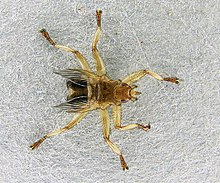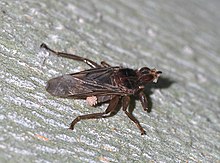| Hippoboscidae | |
|---|---|

| |
| The flightless Crataerina pallida | |
| Scientific classification | |
| Domain: | Eukaryota |
| Kingdom: | Animalia |
| Phylum: | Arthropoda |
| Class: | Insecta |
| Order: | Diptera |
| (unranked): | Eremoneura |
| (unranked): | Cyclorrhapha |
| Section: | Schizophora |
| Subsection: | Calyptratae |
| Superfamily: | Hippoboscoidea |
| Family: | Hippoboscidae Samouelle, 1819 |
| Subfamilies | |
| Synonyms | |
|
Hypoboscidae (lapsus) | |
Hippoboscidae, the louse flies or keds, are obligate parasites of mammals and birds. In this family, the winged species can fly at least reasonably well, though others with vestigial or no wings are flightless and highly apomorphic. As usual in their superfamily Hippoboscoidea, most of the larval development takes place within the mother's body, and pupation occurs almost immediately.[2]

The sheep ked, Melophagus ovinus, is a wingless, reddish-brown fly that parasitizes sheep. The Neotropical deer ked, Lipoptena mazamae, is a common ectoparasite of white-tailed deer (Odocoileus virginianus) in the southeastern United States. Both winged and wingless forms may be seen. A common winged species is Hippobosca equina, called "the louse fly". Species in other genera are found on birds; for example, Ornithomya bequaerti has been collected from birds in Alaska. Two species of the Hippoboscidae – Ornithoica (Ornithoica) podargi and Ornithomya fuscipennis are also common parasites of the tawny frogmouth (Podargus strigoides) of Australia.
Pseudolynchia canariensis is commonly found on pigeons and doves, and can serve as the vector of "pigeon malaria". Louse flies of birds may transmit other parasites such as those in the genus Plasmodium or other Haemoproteus parasites. Some evidence indicates that other Hippoboscidae can serve as vectors of disease agents to mammals. For example, a louse fly of the species Icosta americana was found with West Nile Virus infection from an American Kestrel.[3]
- ^ Maa, T. C. (1969). "A Revised Checklist and Concise Host Index of Hippoboscidae (Diptera)" (PDF). Pacific Insects Monograph. 20. Honolulu: Bishop Museum, Honolulu, Hawaii: 261–299.
- ^ Hutson, A.M (1984). Diptera: Keds, flat-flies & bat-flies (Hippoboscidae & Nycteribiidae). Handbooks for the Identification of British Insects. Vol. 10 pt 7. Royal Entomological Society of London. p. 84.
- ^ Bó, M. Susana; Cabezas, Sonia; Martínez, Pablo; Sarasola, José H.; Cicchino, Armando C.; Santillán, Miguel Á; Liébana, M. Soledad (2011). "Ectoparasites In Free-Ranging American Kestrels In Argentina: Implications for the Transmission of Viral Diseases". Journal of Raptor Research. 45 (4): 335–342. doi:10.3356/JRR-11-26.1. hdl:11336/81706. ISSN 0892-1016. S2CID 54918715.